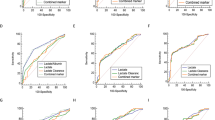Abstract
The present study was conducted to study the significance of lactate as a prognostic marker in patients of septic shock with acute respiratory distress syndrome. This study was conducted on 50 critically ill patients of septic shock with acute respiratory distress syndrome between the age group of 20–60 years and 50 controls. Plasma lactate and serum electrolytes were determined among controls and patients. Arterial blood gas analysis for pO2, pCO2 and pH was carried out among patients. Arterial base excess and anion gap were calculated and lactate was correlated with base excess, anion gap and pCO2 at 5% level of significance. Higher lactate, negative arterial base excess, high anion gap, low pO2 and high pCO2 were observed among patients. Lactate was positively correlated pCO2 and anion gap and negatively with pO2 and base excess among patients. Hyperlactatemia increasing with progression of septic shock with acute respiratory distress syndrome may suggest that lactate may be used as noninvasive prognostic marker or guide to resuscitation.
Similar content being viewed by others
References
Bernard GR, Artigas A, Brigham KL, Carlet J, Falke K, Hudson L, Lamy M, Legall JR, Morris A, Spragg R. The American-European Consensus Conference on ARDS. Definitions, mechanisms, relevant outcomes and clinical trial coordination. Am J Respir Crit Care Med 1994; 149(3): 818–824.
Leverve XM, Mustafa I. Lactate. A key metabolite in the intercellular metabolic interplay. Crit Care 2002; 6(4): 284–285.
David B Sacks. Carbohydrates. In: Burtis AC, Ashwood RE, editors. Tietz text book of clinical chemistry 4th edn: Philadelphia: Saunders; 2006: 837–901.
Mitchell GS, James SK. Electrolytes and blood gases. In; Burtis AC, Ashwood RE, editors. Tietz textbook of clinical chemistry 4th edn:Philadelphia: Saunders;2006: 983–1018.
Caples SM, Hubmayr RD. Respiratory monitoring tools in the intensive care unit. Curr Opinion in Crit Care 2003; 9(3): 230–235.
Siggaard-Andersen O, Wimberly PD, Fogh-Andersen N, Gothgen IH. Measured and derived quantities with modern pH and blood gas equipment: calculation algorithms with 54 equations. Scand J Clin Lab Invest 1988; 48(189): 7–15.
Figge J, Jabor A, Kazda A, Fencl V. Anion gap and hypoproteinemia. Crit Care Med 1998; 26(11): 1807–1810.
Gutierrez G, Wulf-Gutierrez ME, Reines HD. Monitoring oxygen transport and tissue oxygenation. Curr Opinion in Anaesthesiol 2004; 17(2): 107–117.
Routsi CS, Zakynthinos H, Bardouniotou D, Alepopoulou E, Zakynthinos D, Kazi B, Ioanidou, Roussos C. Arteriovenous differences in lactate and lactate pyruvate ratio correlate with hypoxemic lung disease. AmJ Respir Crit Care Med 1996;153(5): 385.
Backer D, Creteur J, Zhang H, Norrenberg M, Vincent JL. Lactate Production by the Lungs in Acute Lung Injury. Am J Respir Crit Care Med 1997; 156(4): 1099–1104.
Kilpatrick-Smith L, Erecinska M. Cellular effects of endotoxin in vitro: I. Effect of endotoxin on mitochondrial substrate metabolism and intracellular calcium. Circ Shock 1983; 11(2): 85–99.
Rhodes A, Cusack RJ. Arterial blood gas analysis and lactate. Curr Opinion in Crit Care 2000; 6(3): 227–231.
Rocktaeschel J, Morimatsu H, Uchino S, Bellomo R. Unmeasured anions in critically ill patients: can they predict mortality? Crit Care Med 2003; 31(8): 2131–2136.
Smith I, Kumar P, Molloy S, Rhodes A, Newman PJ, Grounds RM, Bennett ED. Base excess and lactate as prognostic indicators for patients admitted to intensive care. Inten Care Med 2001; 27(1): 74–83.
Eachempati SR, Reed RL, Barie PS. Serum bicarbonate concentration correlates with arterial base deficit in critically ill patients. Surg Infect (Larchmt) 2003; 4(2): 193–197.
Crawford A. An audit of the patient’s experience of arterial blood gas testing. Br J Nurs 2004; 13(9): 529–532.
Author information
Authors and Affiliations
Corresponding author
Rights and permissions
About this article
Cite this article
Nanda, S.K., Suresh, D.R. Plasma lactate as prognostic marker of septic shock with acute respiratory distress syndrome. Indian J Clin Biochem 24, 433–435 (2009). https://doi.org/10.1007/s12291-009-0078-y
Published:
Issue Date:
DOI: https://doi.org/10.1007/s12291-009-0078-y




